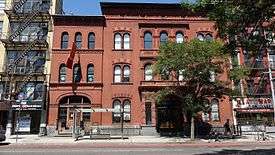Ottendorfer Public Library and Stuyvesant Polyclinic Hospital
|
Ottendorfer Public Library and Stuyvesant Polyclinic Hospital | |
|
Ottendorfer Public Library (left) and Stuyvesant Polyclinic Hospital (right) | |
  | |
| Location |
135 and 137 2nd Avenue Manhattan, New York City |
|---|---|
| Coordinates | 40°43′47″N 73°59′15″W / 40.72972°N 73.98750°WCoordinates: 40°43′47″N 73°59′15″W / 40.72972°N 73.98750°W |
| Built | 1883-84 |
| Architect | William Schickel |
| Architectural style |
Late Victorian Queen Anne Italian Renaissance Revival |
| NRHP Reference # | 79001607[1] |
| Significant dates | |
| Added to NRHP | July 22, 1979 |
| Designated NYCL |
Hospital: November 9, 1976 Library: September 20, 1977 |
The Ottendorfer Public Library and Stuyvesant Polyclinic Hospital are two adjoining historic buildings located at 135 and 137 2nd Avenue in the East Village neighborhood of Manhattan, New York City.
History
The buildings were built in 1883-84 and were designed as a pair by German-born architect William Schickel. They were designed in the neo-Italian Renaissance style, with Philadelphia pressed brick facades ornamented in terra cotta, a relatively new building material to New York.[2] The buildings were a gift to the City of New York by philanthropists Oswald Ottendorfer, a German immigrant and publisher of the Staats-Zeitung, the city's largest German-language newspaper, and his wife Anna Ottendorfer.[3][4]
The Ottendorfer Library was the second branch of the New York Free Circulating Library, and is currently the oldest library in the city to occupy its original building. It opened on December 7, 1884.[5] Even before the library opened, the Ottendorfers had donated their own collection of books to the NYFL.[4]
The Stuyvesant Clinic was originally known as the "German Dispensary", and was affiliated with the German Hospital uptown, now Lenox Hill Hospital. It provided free medical care to German immigrants on the Lower East Side on the model of the Northern Dispensary in Greenwich Village.[2][3] In 1905, the German Hospital began plans to build a dispensary uptown, closer to the hospital, and better located to serve the growing German population of Yorkville. It sold the building in 1906 to another medical charity, the German Polyklinik.[2] This name was changed to "Stuyvesant Polyclinic" due to the anti-German sentiment connected with the entrance of the United States into World War I.[2][6]
The hospital building features terra cotta busts of Hippocrates, Anders Celsius, Alexander von Humboldt, Linnaeus, and Antoine Lavoisier, among others.[2][3][6] The building was restored in 2009 by David Mayerfied.[6]
The Stuyvesant Polyclinic building was designated a New York City landmark in 1976, and the Ottendorfer Library in 1977, with its interior being designated in 1981.[4] Both buildings were added to the National Register of Historic Places in 1979.
See also
- Brandon-Hill list
- National Register of Historic Places listings in Manhattan below 14th Street
- List of New York City Designated Landmarks in Manhattan below 14th Street
References
Notes
- ↑ National Park Service (2009-03-13). "National Register Information System". National Register of Historic Places. National Park Service.
- 1 2 3 4 5 "Stuyvesant Polyclinic Hospital Designation Report" New York City Landmarks Preservation Commission (November 9, 1976)
- 1 2 3 Nevius, Michelle & Nevius, James (2009), Inside the Apple: A Streetwise History of New York City, New York: Free Press, ISBN 141658997X, pp.153-54
- 1 2 3 New York City Landmarks Preservation Commission; Dolkart, Andrew S. (text); Postal, Matthew A. (text) (2009), Postal, Matthew A., ed., Guide to New York City Landmarks (4th ed.), New York: John Wiley & Sons, ISBN 978-0-470-28963-1, pp.66-67
- ↑ Anna Ottendorfer (1815-1884), publisher, philanthropist
- 1 2 3 White, Norval; Willensky, Elliot & Leadon, Fran (2010), AIA Guide to New York City (5th ed.), New York: Oxford University Press, ISBN 9780195383867, p.197
External links
 Media related to NYPL Ottendorfer Branch at Wikimedia Commons
Media related to NYPL Ottendorfer Branch at Wikimedia Commons- German Traces NYC: Ottendorfer Library and German Dispensary


